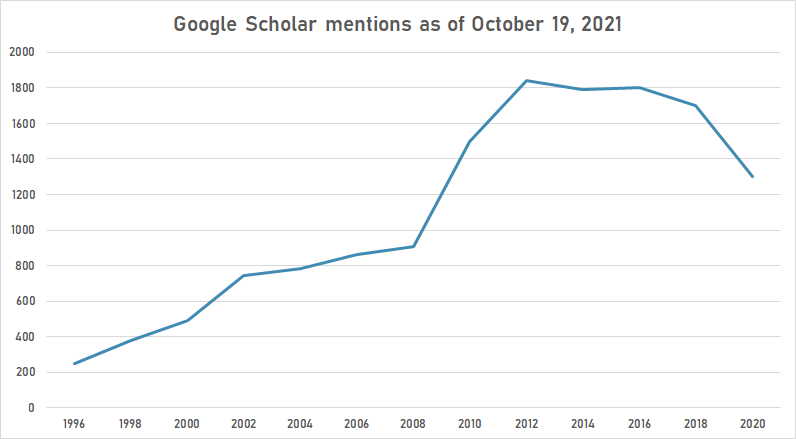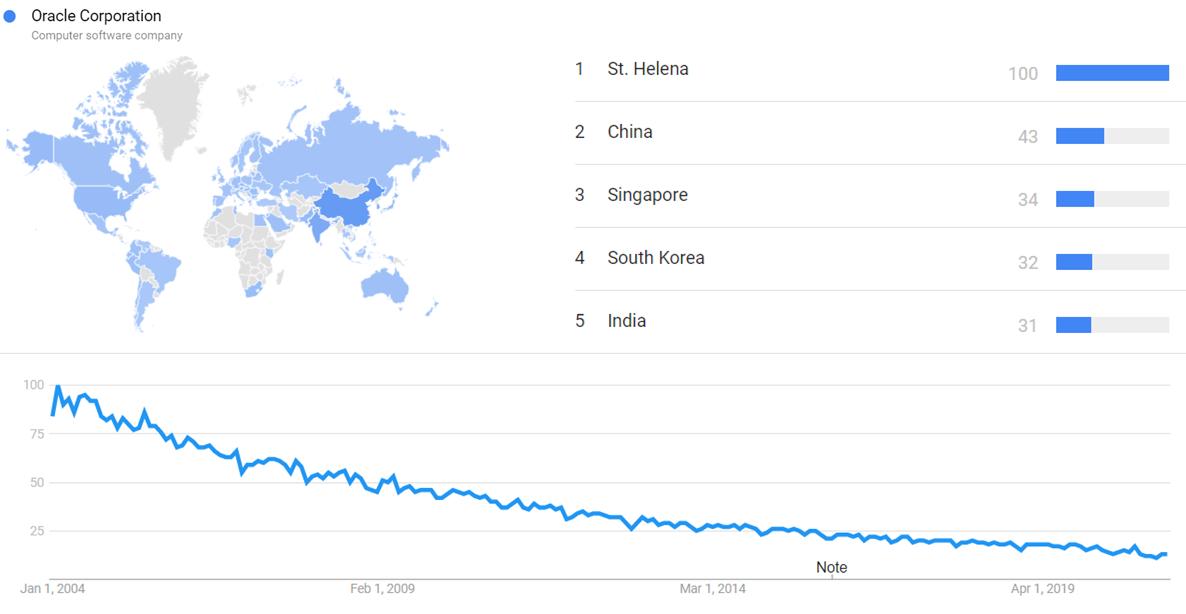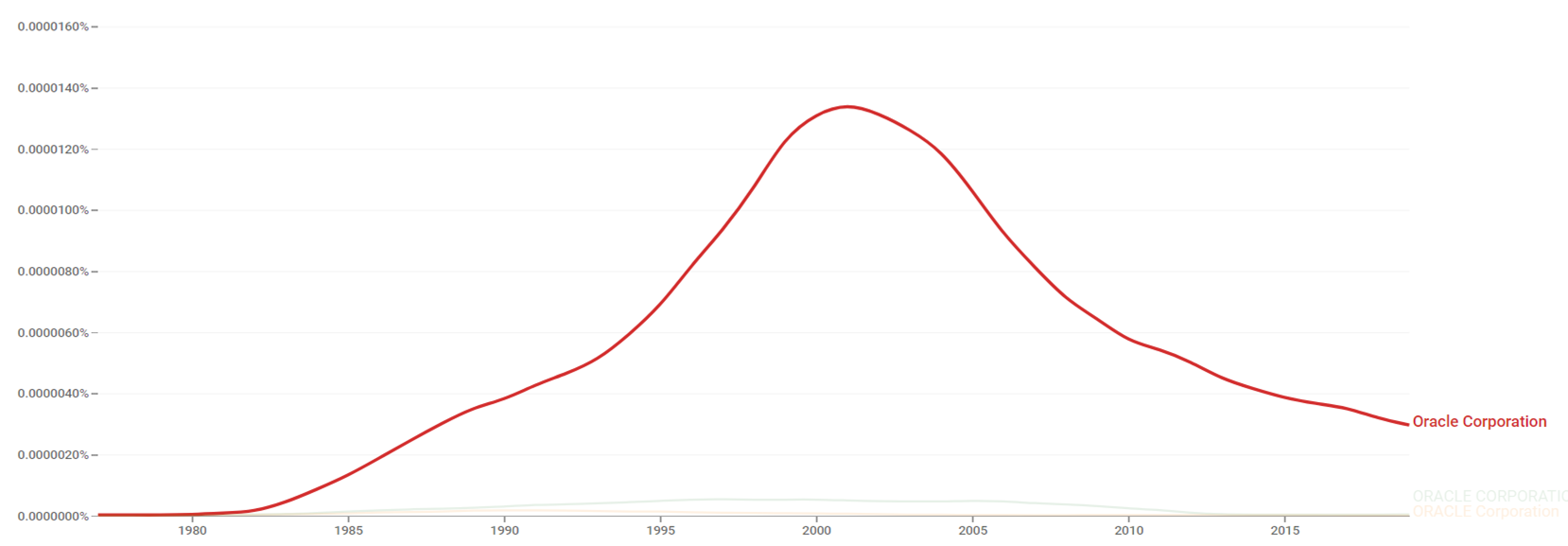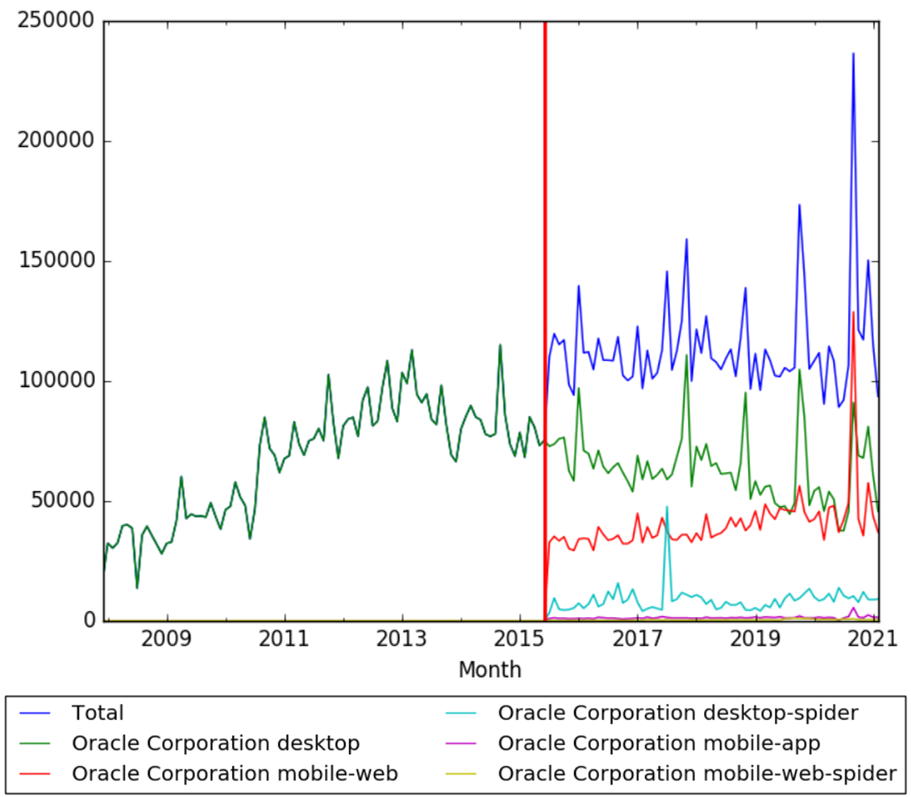Timeline of Oracle Corporation
This is a timeline of Oracle Corporation, an American multinational computer technology corporation.
Contents
Big picture
| Time period | Development summary |
|---|---|
| 1970s | System Development Laboratories (the precursor to Oracle Corporation), is founded in the second half of the 1970s. The Oracle Relational Database Manager System (the first commercially available Relational database management system) is developed in the first years.[1] |
| 1980s | Oracle begins the decade jousting with new entrants in the database-management system market. The company adopts officially the name Oracle after its flagship product, the Oracle database. The company's reputation for innovations and its aggressive advertising style, helps to push Oracle's sales upward.[2] In 1986 Oracle goes public on NASDAQ and launches its SQL *Star software. Oracle's customer base grows to include 2,000 mainframe and minicomputer users represented by major international firms operating in such fields as the aerospace, automotive, pharmaceutical, and computer manufacturing industries, as well as a variety of government organizations.[2] By 1987, Oracle is confirmed as the world’s largest database management software company.[1] |
| 1990s | Oracle nearly goes bankrupt early in the decade.[3] In 1991, the company experiences its first fiscal loss. In 1992 Nippon Steel Corporation buys a stake in Oracle Japan; and Oracle7 makes its debut. By mid-1994, Oracle's sales reach US$2 billion, with its consulting services accounted for a healthy 20 percent of sales.[2] In 1997 Network Computer Inc. is established. In 1999 Oracle Japan goes public.[2] |
| 2000s | In early 2000 Oracle establishes multiple joint ventures, including one with Texas-based Entrust Technologies, Inc. for a new database program called Oracle Advanced Security.[2] In 2001, Oracle's database system is the first to pass nine industry standard security evaluations.[1] In 2003, Oracle attempts a hostile takeover of rival PeopleSoft. In 2004, the US Department of Justice files multiple antitrust lawsuits to prevent Oracle's takeover of PeopleSoft. In 2009 Oracle acquires Sun Microsystems. |
| 2010s | Oracle starts the decade with a huge acquisition, after buying Sun Microsystems. As of 2017, Oracle has more than 430,000 customers and is present in 175 countries. The company has more than 138,000 employees.[3] |
Full timeline
| Year | Event type | Details |
|---|---|---|
| 1977 | Software Development Laboratories (SDL) is founded by Larry Ellison, Bob Miner and Ed Oates.[4][5] | |
| 1978 | The Oracle Relational Database Manager Program is developed.[4] | |
| 1978 | Software Development Laboratories is renamed Relational Software Inc. (RSI).[3][6] | |
| 1979 | Product | RSI releases Oracle database, the earliest commercial relational database program to use Structured Query Language (SQL). The program would quickly became popular, with the United States Air Force as the first costumer.[5] |
| 1979 | Oracle V2 (Version 2) is introduced as the first commercially available SQL-based RDBMS.[7] | |
| 1981 | Relational Software Inc. begins developing tools for Oracle, including the Interactive Application Facility, a predecessor of Oracle Forms.[8] | |
| 1982 | Brand | Relational Software Inc. is renamed Oracle Systems Corp, after its flagship product.[6][5][3] |
| 1982 | International expansion | Oracle establishes its first international subsidiary, Oracle Denmark.[4] |
| 1983 | Product | Oracle database Version 3 is released, becoming the first relational database management system to run on mainframes, minicomputers and PCs, giving customers the ability to use the software in almost any enterprise computing environment.[6][9][10] The new version features concurrency control, data distribution, and scalability. |
| 1983 | Brand | Oracle Systems becomes Oracle Corporation.[4] |
| 1984 | Product | Oracle database Version 4 is released, featuring multiversion read consistency. Oracle ports Oracle Database to the PC platform. The MS-DOS version (4.1.4) of Oracle runs in only 512K of memory.[8] |
| 1984 | Revenue | Oracle's sales double to US$12.7 million.[11] |
| 1985 | International expansion | Oracle Canada is established.[12] |
| 1985 | Product | Oracle database Version 5 is released, featuring support for client/server computing and distributed database systems. It is one of the first relational database management systems to operate in client/server environments.[8] |
| 1985 | International expansion | Oracle establishes a Japanese subsidiary.[13] |
| 1986 (March) | Financial | Oracle makes its first public offering of stock, selling one million common shares.[4] |
| 1986 | Product | Oracle introduces the first clustered database solution called Oracle Parallel Server (OPS), with Oracle Version 5.[14] |
| 1986 | Userbase | Oracle's customer base grows to include 2,000 mainframe and minicomputer users represented by major international firms operating in such fields as the aerospace, automotive, pharmaceutical, and computer manufacturing industries, as well as a variety of government organizations.[4] |
| 1986 | Expansion | Oracle expands its relational database management system product line and debuts another industry first, a distributed database management system based on the company's SQL*Star software.[15][16] |
| 1986 | Growth | Oracle's year annual sales more than double since the previous year, to a record US$55.4 million.[2] |
| 1987 | Growth | Oracle becomes the largest database management company in the world.[4][5] |
| 1988 | Product | Oracle database Version 6 is released, featuring major advances: Row-level locking allows multiple users to work in the same table, by processing only the specific data used in a transaction. Hot backup reduces system maintenance overhead, by allowing employees to continue working in the system while administrators duplicate and archive data. PL/SQL enables users to process data while it remains in the database.[8] |
| 1989 | Facility | Oracle's new world headquarters opens in Redwood Shores, California.[8] |
| 1990 | Product | Oracle Applications Release 8 is launched, including accounting programs designed for the emerging client/server computing environment.[8] |
| 1990 (April) | Legal | A dozen shareholders bring suit against Oracle, charging the company has made false and misleading earnings forecasts. Oracle announces it would conduct an internal audit and immediately restructured its management team with Lawrence Ellison assuming the additional post of chairman, with Donald L. Lucas remaining as a director.[4] |
| 1990 | Recognition | Oracle Chief Executive Officer Larry Ellison is lauded for his accomplishments, being named Entrepreneur of the Year for 1990 by the Harvard School of Business.[2] |
| 1991 | Revenue | Oracle experiences its first fiscal loss.[4] |
| 1992 | Acquisition | "Nippon Steel Corporation buys a stake in Oracle Japan; Oracle7 makes its debut."[4] |
| 1992 (June) | Product | Oracle7 is released, featuring PL/SQL stored procedures, triggers, distributed 2-phase commit, shared cursors, and cost Based Optimizer[7] |
| 1993 | Oracle becomes the first software company to rewrite business applications to run in client/server environments and automating business processes from a centralized data center.[6] | |
| 1994 | Oracle earns the first independent security evaluations in the industry, adding third-party assurance of the strength of Oracle’s products.[8] | |
| 1994 (Mid-year) | Revenue | Oracle's sales reach US$2 billion, with its consulting services accounting for 20 percent of sales.[4] |
| 1995 | Brand | Oracle Systems Corp is renamed Oracle Corp.[3] |
| 1995 | Strategy | Oracle announces a comprehensive internet strategy, becoming the first major software company to do so.[8] |
| 1996 | Product | Oracle 7.3 is released with the Universal Server delivery, allowing customers to use Oracle to manage any type of data –text, video, maps, sound or images.[6] |
| 1997 (June) | Product | Oracle 8 database is launched[4], featuring recovery manager and partitioning. |
| 1998 | With the Oracle8 database and Oracle Applications 10.7, Oracle becomes the first enterprise computing company to embrace the Java programming language.[6][17] | |
| 1999 | Financial | Oracle Corporation Japan goes public.[4] |
| 1999 | Partnership | Oracle teams up with Hewlett-Packard Company to integrate HP's e-business applications with its database management software.[4] |
| 1999 | Product | Oracle8i Database is released, providing native support for internet protocols and server-side support for Java. Oracle8i is designed for internet computing, enabling the database to be deployed in a multitier environment.[7] |
| 2000 | Expansion | Oracle establishes multiple joint ventures, including one with Texas-based Entrust Technologies, Inc. for a new database program called Oracle Advanced Security.[4] |
| 2000 | Product | Oracle E-Business Suite 11i and Technology Network (OTN) Xchange are introduced, with the former being the first integrated suite of enterprise applications.[4][8] |
| 2000 | Revenue | Oracle finishes fiscal year with revenues of US$10.2 billion and earnings at an all-time high of $6.3 billion due to an extra $4 billion from selling shares in Oracle Japan.[4] |
| 2000 | Expansion | Oracle Corporation founds the Oracle Mobile subsidiary.[18] |
| 2001 | Oracle's database system becomes the first to pass nine industry standard security evaluations.[4] | |
| 2001 | Recognition | Oracle Small Business Suite is considered "Best of the Web" by Forbes magazine.[4] |
| 2001 | Product | Oracle9i Database introduces Oracle RAC, enabling multiple instances to access a single database simultaneously. Additionally, Oracle XML Database (Oracle XML DB) introduces the ability to store and query XML. |
| 2003 | Acquisition | Oracle attempts a hostile takeover of rival PeopleSoft– a provider of human resource management systems (HRMS). In mid-year Oracle initiates the takeover for US$5.1 billion.[4] |
| 2003 | Product | Oracle Database 10g is launched as the first grid computing database available for the enterprise. Oracle Grid Computing serves computing power across the enterprise as a utility, automatically shifting processing loads based on demand.[6][19] |
| 2004 | Acquisition | The United States Department of Justice files multiple antitrust lawsuits to prevent Oracle's takeover of PeopleSoft.[4] |
| 2004 (December 13) | Acquisition | Oracle Corporation signs an agreement to acquire PeopleSoft after a long hard battle. The acquisition would be transacted for US$26.50 per share which equals US$10.3 billion.[20][21][22] |
| 2005 (January 14) | Staff | Oracle announces a reduction of their combined workforces to 50,000.[18] |
| 2006 | Acquisition | Oracle acquires Siebel Systems– a provider of Customer relationship management, for US$5.85 billion.[20] |
| 2006 (April 12) | Acquisition | Oracle announces the acquisition of Portal Software, Inc.[18] |
| 2006 (October) | Product | Oracle announces Unbreakable Linux, a Linux distribution packaged and freely distributed by Oracle, available partially under the GNU General Public License.[18][23] |
| 2007 (March 22) | Legal | Oracle sues German-based European multinational software corporation SAP, accusing them of fraud and unfair competition. The court case would last until 23rd November 2010 where Oracle wins the US$1.3 billion lawsuit, known as the largest software piracy judgement in history.[18] |
| 2007 (May 15) | Acquisition | Oracle acquires Agile Software Corporation, a San Jose, California–based company that provides product lifecycle management (PLM) software.[18] |
| 2007 | Acquisition | Orcle pays US$3.3 billion for the acquisition of Hyperion Corporation, a provider of enterprise performance management software.[24][25][26] |
| 2008 | Acquisition | Oracle acquires BEA Systems, a provider of application development and middleware software platform, for US$8.5 billion in 2008.[20] |
| 2009 (April 20) | Acquisition | Oracle acquires Sun Microsystems after paying US$7.4 billion, its largest acquisition.[27][28][29] |
| 2010–2016 | Legal | In late 2010 Oracle files a multibillion-dollar lawsuit against Google, Inc., alleging that Google has illegally used elements of Java in its development of the Android operating system for mobile phones. In 2016, after years of litigation and a remanded trial, a jury finds that Google has not violated Oracle’s copyrights.[5] |
| 2011 (March 24) | Revenue | Oracle publicizes its achievements boasting fiscal 2011 Q3 GAAP total revenues up by 37% to US$8.8 billion and non-GAAP total revenues up by 36% to US$8.8 billion.[18] |
| 2011 (October 24) | Acquisition | Oracle pays US$1.5 billion for RightNow Technologies, a customer relationship management (CRM) software service for enterprise organizations.[30][31][32] |
| 2012 (February 9) | Acquisition | Oracle pays US$1.9 billion for the acquisition of Taleo Corporation, a leading provider of cloud-based talent management.[33][34][35] |
| 2013 (December 20) | Acquisition | Oracle pays US$1.5 billion for the acquisition of Responsys, Inc., a leading provider of enterprise-scale cloud-based B2C marketing software.[36][37][38] |
| 2014 (September) | Staff | Larry Ellison steps down, and Mark Hurd becomes Oracle's chief executive officer.[39] |
| 2014 | Recognition | Oracle Financials is ranked in the Top 20 Most Popular Accounting Software Infographic by Web service Capterra.[40] |
| 2014 (June 23) | Acquisition | Oracle acquires MICROS Systems, – a retail and hospitality hardware/software systems provider, for US$5.3 billion.[41][42][43] |
| 2014 (December 22) | Acquisition | Oracle acquires consumer data collection company datalogix, for US$1.2 billion.[44][45][46] |
| 2015 | Growth | Oracle is the second-largest software maker by revenue, after Microsoft.[47] |
| 2016 (July 28) | Acquisition | Oracle acquires American cloud computing company NetSuite for US$9.3 billion in 2016. NetSuite provides Software as a Service platform for enterprise resource planning (ERP).[48][49][50] |
| 2017 (December 17) | Acquisition | Oracle pays US$1.2 billion for the acquisition of Aconex Limited, a leading cloud-based solution that manages team collaboration for construction projects.[51][52][53] |
| 2017 | Revenue | Oracle's annual revenues exceed US$37 billion.[3] |
Numerical and visual data
Google Scholar
The following table summarizes per-year mentions on Google Scholar as of October 19, 2021.
| Year | "Oracle Corporation" |
|---|---|
| 1996 | 251 |
| 1998 | 381 |
| 2000 | 489 |
| 2002 | 742 |
| 2004 | 781 |
| 2006 | 864 |
| 2008 | 905 |
| 2010 | 1,500 |
| 2012 | 1,840 |
| 2014 | 1,790 |
| 2016 | 1,800 |
| 2018 | 1,700 |
| 2020 | 1,300 |
Google Trends
The image below shows Google Trends data for Oracle Corporation (Computer software company), from January 2004 to March 2021, when the screenshot was taken. Interest is also ranked by country and displayed on world map.[54]
Google Ngram Viewer
The chart below shows Google Ngram Viewer data for Oracle Corporation, from 1977 to 2019.[55]
Wikipedia Views
The chart below shows pageviews of the English Wikipedia article Oracle Corporation, on desktop from December 2007, and on mobile-web, desktop-spider, mobile-web-spider and mobile app, from July 2015; to February 2021.[56]
Meta information on the timeline
How the timeline was built
The initial version of the timeline was written by User:Sebastian.
Funding information for this timeline is available.
Feedback and comments
Feedback for the timeline can be provided at the following places:
- FIXME
What the timeline is still missing
Timeline update strategy
See also
External links
References
- ↑ 1.0 1.1 1.2 "A Brief History of Oracle Corporation". authorstream.com. Retrieved 29 May 2018.
- ↑ 2.0 2.1 2.2 2.3 2.4 2.5 2.6 "Oracle Corporation". encyclopedia.com. Retrieved 29 May 2018.
- ↑ 3.0 3.1 3.2 3.3 3.4 3.5 "Tales in Tech History: Oracle". silicon.co.uk. Retrieved 29 May 2018.
- ↑ 4.00 4.01 4.02 4.03 4.04 4.05 4.06 4.07 4.08 4.09 4.10 4.11 4.12 4.13 4.14 4.15 4.16 4.17 4.18 4.19 4.20 "Oracle Corporation History". fundinguniverse.com. Retrieved 21 May 2018.
- ↑ 5.0 5.1 5.2 5.3 5.4 "Oracle Corporation". britannica.com. Retrieved 21 May 2018.
- ↑ 6.0 6.1 6.2 6.3 6.4 6.5 6.6 "Partners Found Software Development Laboratories". eweek.com. Retrieved 21 May 2018.
- ↑ 7.0 7.1 7.2 "1 Introduction to Oracle Database". docs.oracle.com. Retrieved 21 May 2018.
- ↑ 8.0 8.1 8.2 8.3 8.4 8.5 8.6 8.7 8.8 "Oracle Milestones: From ZERO to HERO". sshailesh.wordpress.com. Retrieved 22 May 2018.
- ↑ Krishnan, Sriram. Programming Windows Azure: Programming the Microsoft Cloud.
- ↑ Malonis, Jane A. Gale encyclopedia of e-commerce.
- ↑ Symonds, Matthew. Softwar: An Intimate Portrait of Larry Ellison and Oracle.
- ↑ Blue Book of Canadian Business, 1993. Canadian Newspaper Services International.
- ↑ Look Japan, Issues 487-490; Issues 494-506.
- ↑ Vallath, Murali. Oracle Real Application Clusters.
- ↑ Kepos, Paula; Derdak, Thomas. International Directory of Company Histories, Volume 6.
- ↑ International Directory of Company Histories, Volume 6. St. James Press.
- ↑ "Essay: Brief History of Oracle Database". marketoracle.co.uk. Retrieved 29 May 2018.
- ↑ 18.0 18.1 18.2 18.3 18.4 18.5 18.6 "The History of Oracle Corporation: 2000 – 2013". dsp.co.uk. Retrieved 29 May 2018.
- ↑ Greenwald, Rick; Stackowiak, Robert; Stern, Jonathan. Oracle Essentials: Oracle Database 12c.
- ↑ 20.0 20.1 20.2 "A look at Oracle's 10 biggest acquisitions". networkworld.com. Retrieved 29 May 2018.
- ↑ "Oracle Buys PeopleSoft". oracle.com. Retrieved 29 May 2018.
- ↑ "It's official: Oracle closes on PeopleSoft acquisition". computerworld.com. Retrieved 29 May 2018.
- ↑ "Oracle Linux FAQ" (PDF). Oracle Corporation. Retrieved 29 May 2018.
- ↑ "Oracle buys Hyperion for $3.3 billion". cnet.com. Retrieved 30 May 2018.
- ↑ "Oracle and Hyperion: is it really a strategic fit?". theregister.co.uk. Retrieved 30 May 2018.
- ↑ "Oracle buys Hyperion, turns heat on SAP". theregister.co.uk. Retrieved 30 May 2018.
- ↑ "Oracle Buys Sun". oracle.com. Retrieved 30 May 2018.
- ↑ "How Has The SUN Acquisition Worked Out For Oracle?". forbes.com. Retrieved 30 May 2018.
- ↑ "Oracle to buy Sun for $7.4B after IBM drops bid". abcnews.go.com. Retrieved 30 May 2018.
- ↑ Dignan, Larry. "Oracle acquires RightNow for $1.5 billion, aims turrets at Salesforce.com". zdnet.com. Retrieved 29 May 2018.
- ↑ Pallatto, John. "Oracle Buys RightNow Technologies for $1.5B to Expand CRM Portfolio". eweek.com. Retrieved 29 May 2018.
- ↑ Frier, Sarah. "Oracle Buys RightNow for $1.5 Billion to Add Cloud Services". bloomberg.com. Retrieved 29 May 2018.
- ↑ "Oracle Buys Taleo". oracle.com. Retrieved 30 May 2018.
- ↑ "Oracle buying Taleo for $1.9 billion, cloud war brews". reuters.com. Retrieved 30 May 2018.
- ↑ "Oracle Buys Talent Management Solutions Company Taleo For $1.9 Billion". techcrunch.com. Retrieved 30 May 2018.
- ↑ "Oracle Buys Responsys". oracle.com. Retrieved 30 May 2018.
- ↑ "Oracle to buy Responsys for $1.39 billion in cloud software push". reuters.com. Retrieved 30 May 2018.
- ↑ "Oracle Acquires Responsys". constellationr.com. Retrieved 30 May 2018.
- ↑ "Oracle CEO Larry Ellison steps down, Catz and Hurd named CEOs". cnbc.com. Retrieved 30 May 2018.
- ↑ "Best Donation Management Software - 2015 Reviews of the Most Popular Systems". Retrieved May 21, 2018.
- ↑ Bort, Julie. "This Is Why Oracle Just Made A Huge $5.3 Billion Acquisition". businessinsider.com. Retrieved 29 May 2018.
- ↑ "A Closer Look At Oracle's Acquisition Of MICROS Systems -- Part 1". forbes.com. Retrieved 29 May 2018.
- ↑ "Oracle Completes Acquisition of MICROS Systems". .oracle.com. Retrieved 29 May 2018.
- ↑ "Oracle Buys Datalogix". oracle.com. Retrieved 29 May 2018.
- ↑ "Oracle Has Acquired Datalogix". businessinsider.com. Retrieved 29 May 2018.
- ↑ "Oracle buys Datalogix, beefs up digital marketing cloud". zdnet.com. Retrieved 29 May 2018.
- ↑ "Global 100 Software Leaders by revenue". PriceWaterhouseCoopers. Retrieved May 21, 2018.
- ↑ "Oracle Buys NetSuite". oracle.com. Retrieved 29 May 2018.
- ↑ "Oracle Buys NetSuite". netsuite.com. Retrieved 29 May 2018.
- ↑ "Why NetSuite Is Coming Home To Oracle In $9.3 Billion Acquisition". forbes.com. Retrieved 29 May 2018.
- ↑ "Oracle Buys Aconex". oracle.com. Retrieved 30 May 2018.
- ↑ Shu, Catherine. "Oracle to buy construction collaboration software maker Aconex for $1.2B in cash". techcrunch.com. Retrieved 30 May 2018.
- ↑ "Oracle Agrees to Buy Aconex". aconex.com. Retrieved 30 May 2018.
- ↑ "Oracle Corporation". Google Trends. Retrieved 26 March 2021.
- ↑ "Oracle Corporation". books.google.com. Retrieved 26 March 2021.
- ↑ "Oracle Corporation". wikipediaviews.org. Retrieved 26 March 2021.



